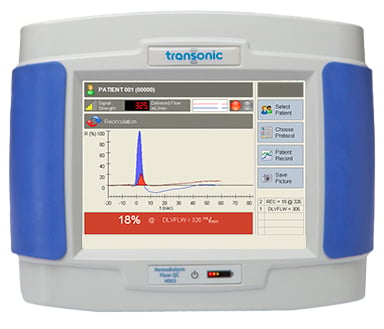Due to the cost associated with supporting multiple generations of HD03 Hemodialysis Monitors it has become prohibitive for Transonic to continue to service or repair Monitors greater than ten (10) years from the date of purchase. The calibration service is available on any HD03 Monitor over ten (10) years old as long as the Monitor does not require repair service. We understand that your HD03 Hemodialysis Monitor may need to be retired if it ages out and requires repair.
We thank you for your utilization of the Transonic HD03 Monitor measurements to help manage your patients’ vascular accesses. The measurements remain an important tool in your access management process and thus we would like to help support your efforts to replace your Transonic HD03 Hemodialysis Monitor with a new one. The following information can help justify the purchase of a new HD03 Hemodialysis Monitor.
On the Spot Vascular Access Assessment to Optimize Treatment


The Transonic HD03 uses transit-time ultrasound to measure blood flow in the lines. This delivered flow can differ from the dialysis machine setting, so it is important to compare the machine setting to the actual circuit flow to optimize dialysis adequacy. Read More.
Recirculation is the mixing of dialyzed and undialyzed blood in the vascular access. Access recirculation is an important cause of inadequate dialysis therapy. Our HD03 meter can measure the exact percentage of recirculation, helping you be sure your patients are receiving their correct dialysis treatment. Read More.
The Transonic ultrasound dilution method is used to measure the blood flow (Access Flow) inside the vascular access in mL/min. Changes in the Access Flow can indicate access dysfunction, including inflow stenosis and outflow stenosis. The Access Flow measurements are used to trend changes over time and to confirm other clinical indicators, including physical exam indications of dysfunction. Access Flow greater than 2000 mL/min can be an indication of potential high output cardiac failure. The HD03 measures Access Flow up to 4000 mL/min. Read More.
Your Transonic Representative can provide you with any additional information including a price quote. Please click here to submit a request for the Transonic Representative to follow-up with you.